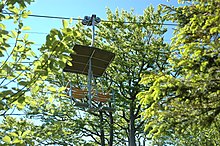Coupling clamp

Detachable terminal blocks are components of cable cars, namely gondolas , detachable chairlifts and Combined installations . They represent the connection between the vehicle and the rope. In the stations, they are opened to detach the vehicle from the rope so that the passengers can get on and off at lower speed. Before they leave the station, they are then clamped back onto the rope.
history
The first, simply constructed, couplable clamps were already available at the end of the 19th century, but then only for material ropeways. The first of their kind for passenger transport came on the market after the Second World War. The VR 101 from the Swiss company Von Roll was the first such clamp, and a few more followed. In addition to cabins, sideways armchairs, i.e. armchairs with two seats across the direction of travel, also appeared at the beginning . At the same time, terminals for 2S cableways were also created , but these almost exclusively with cabins. Such railways were built in various countries in the Alps as well as in the rest of the world, for example in the Czech Republic. The terminal construction methods have been renewed or improved over and over again. In the 1970s, the French company Pomagalski offered the first detachable chairlifts that are common today. Many other manufacturers followed, so that many new terminals were developed again. The construction methods in detail have often been outdated to this day, today the terminal types Doppelmayr Torsion , Agamatic , Euro and Wopfner are in use.
General functionality
The clamping force with which the clamps press on the rope is applied by helical compression springs or disc springs . Historical clamps made partial or full use of gravity . To open the clamp, a rail in the station actuates a lever that opens the clamp. Earlier clamps also used a toothed wheel, which is triggered by a toothed rail, or the cabins were simply lifted, which eliminated gravity. With new cable cars, sensors monitor the coupling process electronically and stop the cable car if necessary.
All terminals can be divided into monostable and bistable terminals. Monostable clamps close automatically if they are not held open by a coupling rail. This means that they close again immediately after disengaging, pass the station in a closed state and are then opened again in order to re-engage. They are seldom held open by means of a rail while driving through the station. Bistable clamps are opened when entering the station and remain open when driving through the station without any additional force being applied, they are then closed again when leaving. On the basis of their functional principle, bistable clamps can be further subdivided into toggle clamps, cam clamps and screw clamps.
Different models
In the following, only a selection of important terminals is described, as it would go beyond the scope of describing all terminals that ever existed (source: see web link "Dome history from 1873 to today") :
VR 101

The VR 101, developed by the Swiss company Von Roll , was the world's first detachable clamp designed for the transport of people. It was first used in 1945 by the Foppa chairlift in Flims . It produces its clamping force through gravity and the use of springs. It was used primarily for side chairlifts, but also for gondolas with two seats. The only remaining cable car with this system is the one on the Komáří hůrka in the Czech Republic.
Giovanola
One of the first couplable clamps is that of the Valais company Giovanola . It is based solely on gravity to apply the clamping force. It was first used in 1950 on the Croix des Ruinettes cable car in Verbier . Later it was only used once by a chairlift, namely at Bray Head in Ireland . After Giovanola withdrew from the cable car business, other manufacturers installed this clamp system, so that it was installed for a total of about 40 years. Today there are still many such systems, for example the cable car in the Westfalenpark in Dortmund.
Wopfner
In 1989, the Austrian company Wopfner developed a detachable clamp that uses coil springs to provide its clamping force. The company no longer exists today, but the manufacturers Bartholet and Loipolder still use this clamp today.
Euro
The two cooperating manufacturers Leitner AG and Pomagalski both use this clamp, developed in 1997, which works with the help of coil springs.
Doppelmayr torsion
The clamp developed by Doppelmayr in 1994 generates the clamping force by means of bar springs and is still installed today.
Agamatic
The Agamatic clamp was developed by the Italian company of the same name and is used today by Doppelmayr.
Coupling clamps on other cable car systems
Modifications of the three classic systems mentioned above, such as the Funitel or the 3S-Bahn , also use couplable terminals.
Web links
- Dome history from 1873 until today. In: Seilbahnforum. www.bergbahnen.org, accessed on March 21, 2020 (list and description of couplable terminals, also a source for the entire section “Various models”).
Individual evidence
- ↑ a b Elmar Dorigatti: Die Welt der Seilbahnen , Folio Verlag, Vienna / Bozen 2019, ISBN 978-3-85256-791-4 , page 26.
- ↑ Cable car encyclopedia - history & technology - 1.8 Detachable cable cars with circulating operation. In: Seilbahnlexikon. www.bergbahnen.org, accessed on March 21, 2020 .
- ↑ Discussion about the terminal of a cable car in Saarbrücken in the forum of www.bergbahnen.org
- ↑ Explanation of the functionality of terminals and division into different categories
- ↑ 50 years of the Bray cable car ruins. In: Seilbahnforum. www.bergbahnen.org, August 11, 2019, accessed on March 21, 2020 (report on the Bray chairlift).
- ^ Ropeway Lexicon - History & Technology - 1.9 Modifications of the classic types of aerial ropeway. In: Seilbahnlexikon. www.bergbahnen.org, accessed on March 21, 2020 (description of modified gondola lifts).
